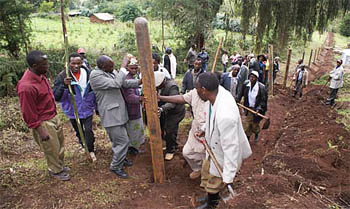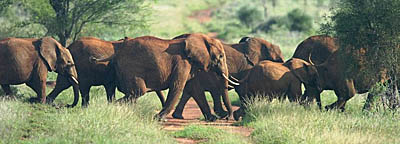Protecting the Aberdares ecosystem required keeping the local people from poaching the wildlife, grazing it with livestock, and cutting the indigenous trees for firewood. A 24-mile electric fence enclosing 850 square miles (one-quarter the size of Yellowstone National Park) could accomplish this task, but only if the locals saw a direct benefit from it.
By Terry Anderson
As we sat eating dinner, a dark shadow loomed in the doorway of the dining room. We turned to consider its source and saw a huge bull elephant, red from rolling in the surrounding soil, heading for a drink of the sweet rain water collected in the cistern. Because the best view was from the bedroom, we pushed back from the meal and quickly went there. Our Kenyan friend, Wycliffe, opened the curtain to expose the giant pachyderm’s trunk reaching for the water less than 10 feet from where we stood, with only a thin pane of glass separating us.
Not happy with his audience, the bull flared his ears in a sign of anger, causing us to close the curtain and retreat to the “safety” of the dining room, leaving the elephant to drink in peace. How did we get into this perilous situation?
We were in Aberdare National Park in Central Kenya at the invitation of Colin Church and the foundation which he chairs, Rhino Ark. To get there we hired a driver and Toyota Land Cruiser and drove three hours from Nairobi. Our first stop was the park headquarters, where we registered for entry into the park and paid our fees.
For three days we would be visiting the dense, high mountain forests starting at 6,800 feet and rising to over 10,000, the cost was $370-$50 per person per day for foreigners, $20 for Kenyan citizens (Wycliffe and David), and $30 for the vehicle. We were issued a Smart Card, similar to a debit card, which we were to present at the gate, a pretty high-tech way of proving that we paid and of monitoring gate attendants to ensure that they were not skimming money from the park.
Though the Smart Cart was high-tech, it was obvious that the Aberdares would be a wilderness experience the instant we left the headquarters (not located within the park) and started up the road to the main gate. That road was not paved and not even graveled; it was mostly two deep ruts with an occasional diversion to two tyre tracks through the grass. Along the way, small, productive corn (maize) fields were tended by their owners; children walked along, some dressed in school uniforms and some carrying huge loads of sticks to fuel the home fires; and we passed through a tiny village which sported a blue shack with a sign reading “Highway Shop”.
We arrived at the gate displaying two rhino silhouettes cut from metal and were greeted by a Kenya Wildlife Service (KWS) armed guard and a “customer service representative”.
The former was a demonstration that the park was serious about keeping poachers out and wildlife in, and the latter was to check our Smart Card. More impressive than the guard and the high tech, however, were the many strands of electric wire running in both directions from the gate. As we learned the next day that is what this visit was all about.
FEE
The road improved once we passed through the gate, thanks partly to the high entrance fee, but it still resembled nothing one would find in a US national park. As the rain poured and the Land Cruiser slid sideways, it was clear the four-wheel drive was a necessary mode of transportation.
The dense bush presented long vistas found in other parts of Kenya and provided perfect cover for the wildlife. The occasional clearing surprised us, up close and personal, with ugly warthogs, fleeting bushbuck, menacing Cape buffalo, and enormous forest elephants. Though we saw no black rhino or bongo, two very rare species found in Aberdares, the abundance of other animals made it evident that KWS was accomplishing its goal of conserving wildlife.
Miles from the entrance we came to our wilderness accommodation, Rhino Retreat, a small lodge built by British army engineers in the early 1990s. The lodge consists of three bedrooms for guests, a living room and dining room complete with a fireplace and spectacular view of Mount Kenya, a kitchen, and staff quarters. As a “self-catering” lodge, Rhino Retreat requires that visitors bring their own food, though Sammy is there to do the cooking, and 20 litres of fuel for the generator which supplies the electricity.
Rhino Retreat is surrounded by lava rocks that ostensibly keep large animals such as elephant described earlier from getting too close to the lodge. And it wasn’t just the one big elephant that did not get the message about the purpose of the rock. Four other bulls appeared before the bedroom window to tell us goodnight, and, another night, 25 Cape buffalo bedded down with only the same thin pane of glass to protect us.
One cannot simply book a reservation at the retreat because it is solely for use by Rhino Ark (www.rhinoark.org), a foundation whose mission is “to raise such funds and material support as are required for the building of an electrified fence to encircle both the Aberdares National Park and the demarcated forestry areas which make up the Aberdares Conservation Area”
ECOSYSTEM
Originally the foundation intended to focus on rhino preservation, but realized that it was the ecosystem of the Aberdares Mountain Range that was crucial to pachyderms and other endangered wildlife.
Protecting the Aberdares ecosystem required keeping the local people from poaching the wildlife, grazing it with livestock, and cutting the indigenous trees for firewood. A 240 mile electric fence enclosing 850 square miles (one-quarter the size of Yellowstone National Park) could accomplish this task, but only if the locals saw a direct benefit from it.
After a night of animal watching from our pillows, we headed back to park headquarters for a briefing on the partnership between KWS and Rhino Ark and a lesson in how to make local people see the Aberdares ecosystem as an asset worth preserving. Instantly, Colin Church, chairman of Rhino Ark, seemed like a lifelong friend.
Before becoming chairman, Colin was an international journalist and ran a successful business in Nairobi. He is a gentle person and avid fisherman whose concern for the Aberdares’ wildlife and the ecosystem which supports them has taken him on a 21-year journey to complete the fence around the Aberdares Conservation Area. Viewing the dense, high mountain terrain makes it obvious why the fence took so long to complete. First there was the task of clearing a path through the trees and brush; then of digging a trench three-feet deep to bury woven wire to keep warthogs from digging under the fence; then of digging of post holes; then finding posts that would last; then of powering the fence in a wilderness without electrical service; and finally of patrolling to ensure that the fence is keeping animals in and livestock and wood gatherers out.
Colin beamed as he shows pictures of the animals, waterfalls, and forests inside the fence and describes the day when the final post was sunk into the ground to complete the enclosure. It is clear, however, that his passion goes beyond nature to include the people who live with the park and its animal residents.
PLASTIC
To give us a real sense of what the fence is about, Colin leads us across 30 kilometres of rough mountain roads to the opposite side of the park. There we inspect the plastic posts that bend instead of breaking when elephants test the barrier and check to see that the wires are actually carrying 7,000 volts of solar-powered electricity. This voltage is sufficient to repel even the most aggressive pachyderms.
We also meet eight community leaders, six men and two women, who explain through an interpreter what the fence means to them. Before the fence was completed in October 2009, elephants left the park at night to consume and trample corn crops.
Sometimes they would even seek out the seed corn stored in the hunts, destroying the villagers’ homes and even killing some residents. For these people living on the edge of subsistence, such destruction was more than an inconvenience. With the fence completed, however, their crops, homes, and selves are safe. They explain to us that land values have increased 100% due to the insurance provided by the fence and offer us a bag of plums, surplus produce they would not have had before the fence.
CONSERVATION
Not only does the fence protect them from elephants, it has helped them understand the value of conservation. Some of the villagers have jobs in the park; some are allowed access through the fence to graze their animals in certain areas; and some collect firewood from the exotic trees that are invading the park.
The villagers are also learning about entrepreneurship. They are exploring whether they can grow butterflies — actually cocoons — in the forest and sell them to people in Europe and the United States who can watch the butterflies hatch in their homes, and they are searching for ways to reduce their dependence on wood as a source of fuel.
Thanks to Colin Church and the Rhino Ark fence, Aberdares National Park has become an asset rather than a liability to the community.
For more on Rhino Ark, see “The conservation road less traveled” by Eric Kihiu.





